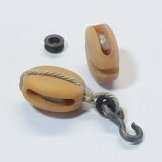-
Posts
1,196 -
Joined
-
Last visited
Reputation Activity
-
 Stuntflyer got a reaction from archjofo in HM Cutter Cheerful 1806 by Stuntflyer (Mike) - FINISHED - 1:48 scale
Stuntflyer got a reaction from archjofo in HM Cutter Cheerful 1806 by Stuntflyer (Mike) - FINISHED - 1:48 scale
Before adding the second layer of wales I applied a coat of Wipe-on poly to the planking. The wales were gradually reduced in thickness about 1" from the stem until they were almost paper thin. Trying to paint the upper wales edges while on the ship is not something I would be comfortable doing. With that in mind I prepainted the edge that would be close to the planking and stem. When gluing the wales, I tried to use as little glue as possible as I wanted to avoid any glue seepage past the painted edge. There was some seepage, though very little, and I was able to remove it easily using a moistened Q-tip. Now I just need to finish painting the wales before starting on the remaining hull planking.
-
 Stuntflyer reacted to rafine in Cutter Cheerful 1806 by rafine - FINISHED
Stuntflyer reacted to rafine in Cutter Cheerful 1806 by rafine - FINISHED
Some progress to report. I completed the prep for planking by adding the square tuck stern piece and fillers and then painting the ports. I opened my last ever bottle of Pollyscale ATSF red for the ports.
I then did the first layer of the wales, which was pretty straightforward. Now, it's on to the topside planking.
Bob
-
 Stuntflyer reacted to augie in USF Confederacy by Augie & Moonbug - FINISHED - Model Shipways - 1:64
Stuntflyer reacted to augie in USF Confederacy by Augie & Moonbug - FINISHED - Model Shipways - 1:64
Has taken about 6 weeks to enjoy our vacation and then address some domestic and minor health issues. But I've finally gotten the shipyard up and running once again.
Decided to finish up the guns on the QD. There are only four 4 pounders due to the layout of the open decking. Once again, the brass cannon were supplied by Chuck's Syren company and they're a perfect fit for the kit-supplied carraiges. No need to detail the construction process again.
I need to finish up one railing on the QD before I move to the bow planking. Will be operating on a reduced 'summer schedule' for a time......but it feels great to be back 'home'.
Here's hoping the summer has been going well for all those here up North. It's been fun following everyone's progress.
-
 Stuntflyer got a reaction from Jay 1 in HM Cutter Cheerful 1806 by Stuntflyer (Mike) - FINISHED - 1:48 scale
Stuntflyer got a reaction from Jay 1 in HM Cutter Cheerful 1806 by Stuntflyer (Mike) - FINISHED - 1:48 scale
Bob, Jay, thanks! I really do appreciate all the comments and "likes".
I'm getting ready to do the second layer of the wales. I hoping to get them done on the first try this time. My difficulty in making the fashion pieces was enough to make me rethink my approach to the various tasks ahead. Anyway, I should have something to show this week if all goes well.
Mike
-
 Stuntflyer got a reaction from PeteB in HM Cutter Cheerful 1806 by Stuntflyer (Mike) - FINISHED - 1:48 scale
Stuntflyer got a reaction from PeteB in HM Cutter Cheerful 1806 by Stuntflyer (Mike) - FINISHED - 1:48 scale
After four previous attempts I can say that I'm now happy with the way these fashion pieces look.
The first photo shows were the counter has more curve at the bottom compared to the template. I was trying to shape the fashion pieces to follow the curve of the counter. This resulted in the pieces being too wide and misshaped. It might not look like much but trying to cover this area of the counter with the fashion pieces changes everything.
The solution was to shape the fashion piece correctly and sand the counter, if necessary, to blend into the shape of the fashion piece. To be honest, very little sanding was necessary which really surprised me. In addition, it wasn't necessary to force the bottom of the fashion piece to a more pronounced curve like I had to before. Once installed they were sanded down to roughly 3/64" in thickness. Now the pieces have a gentle curve and a more delicate shape overall.
-
 Stuntflyer got a reaction from Stoyne in HM Cutter Cheerful 1806 by Stuntflyer (Mike) - FINISHED - 1:48 scale
Stuntflyer got a reaction from Stoyne in HM Cutter Cheerful 1806 by Stuntflyer (Mike) - FINISHED - 1:48 scale
After four previous attempts I can say that I'm now happy with the way these fashion pieces look.
The first photo shows were the counter has more curve at the bottom compared to the template. I was trying to shape the fashion pieces to follow the curve of the counter. This resulted in the pieces being too wide and misshaped. It might not look like much but trying to cover this area of the counter with the fashion pieces changes everything.
The solution was to shape the fashion piece correctly and sand the counter, if necessary, to blend into the shape of the fashion piece. To be honest, very little sanding was necessary which really surprised me. In addition, it wasn't necessary to force the bottom of the fashion piece to a more pronounced curve like I had to before. Once installed they were sanded down to roughly 3/64" in thickness. Now the pieces have a gentle curve and a more delicate shape overall.
-
 Stuntflyer got a reaction from Canute in HM Cutter Cheerful 1806 by Stuntflyer (Mike) - FINISHED - 1:48 scale
Stuntflyer got a reaction from Canute in HM Cutter Cheerful 1806 by Stuntflyer (Mike) - FINISHED - 1:48 scale
Bob, Jay, thanks! I really do appreciate all the comments and "likes".
I'm getting ready to do the second layer of the wales. I hoping to get them done on the first try this time. My difficulty in making the fashion pieces was enough to make me rethink my approach to the various tasks ahead. Anyway, I should have something to show this week if all goes well.
Mike
-
 Stuntflyer reacted to rafine in Cutter Cheerful 1806 by rafine - FINISHED
Stuntflyer reacted to rafine in Cutter Cheerful 1806 by rafine - FINISHED
Thanks guys for the good wishes and welcome aboard.
Chuck, I really don't want to catch you -- so I guess that you're going to have to work faster.
Bob
-
 Stuntflyer reacted to rafine in HM Cutter Cheerful 1806 by Stuntflyer (Mike) - FINISHED - 1:48 scale
Stuntflyer reacted to rafine in HM Cutter Cheerful 1806 by Stuntflyer (Mike) - FINISHED - 1:48 scale
Really nicely done Mike.
Bob
-
 Stuntflyer got a reaction from GuntherMT in HM Cutter Cheerful 1806 by Stuntflyer (Mike) - FINISHED - 1:48 scale
Stuntflyer got a reaction from GuntherMT in HM Cutter Cheerful 1806 by Stuntflyer (Mike) - FINISHED - 1:48 scale
After four previous attempts I can say that I'm now happy with the way these fashion pieces look.
The first photo shows were the counter has more curve at the bottom compared to the template. I was trying to shape the fashion pieces to follow the curve of the counter. This resulted in the pieces being too wide and misshaped. It might not look like much but trying to cover this area of the counter with the fashion pieces changes everything.
The solution was to shape the fashion piece correctly and sand the counter, if necessary, to blend into the shape of the fashion piece. To be honest, very little sanding was necessary which really surprised me. In addition, it wasn't necessary to force the bottom of the fashion piece to a more pronounced curve like I had to before. Once installed they were sanded down to roughly 3/64" in thickness. Now the pieces have a gentle curve and a more delicate shape overall.
-
 Stuntflyer got a reaction from Mike Y in HM Cutter Cheerful 1806 by Stuntflyer (Mike) - FINISHED - 1:48 scale
Stuntflyer got a reaction from Mike Y in HM Cutter Cheerful 1806 by Stuntflyer (Mike) - FINISHED - 1:48 scale
After four previous attempts I can say that I'm now happy with the way these fashion pieces look.
The first photo shows were the counter has more curve at the bottom compared to the template. I was trying to shape the fashion pieces to follow the curve of the counter. This resulted in the pieces being too wide and misshaped. It might not look like much but trying to cover this area of the counter with the fashion pieces changes everything.
The solution was to shape the fashion piece correctly and sand the counter, if necessary, to blend into the shape of the fashion piece. To be honest, very little sanding was necessary which really surprised me. In addition, it wasn't necessary to force the bottom of the fashion piece to a more pronounced curve like I had to before. Once installed they were sanded down to roughly 3/64" in thickness. Now the pieces have a gentle curve and a more delicate shape overall.
-
 Stuntflyer got a reaction from Rustyj in HM Cutter Cheerful 1806 by Stuntflyer (Mike) - FINISHED - 1:48 scale
Stuntflyer got a reaction from Rustyj in HM Cutter Cheerful 1806 by Stuntflyer (Mike) - FINISHED - 1:48 scale
After four previous attempts I can say that I'm now happy with the way these fashion pieces look.
The first photo shows were the counter has more curve at the bottom compared to the template. I was trying to shape the fashion pieces to follow the curve of the counter. This resulted in the pieces being too wide and misshaped. It might not look like much but trying to cover this area of the counter with the fashion pieces changes everything.
The solution was to shape the fashion piece correctly and sand the counter, if necessary, to blend into the shape of the fashion piece. To be honest, very little sanding was necessary which really surprised me. In addition, it wasn't necessary to force the bottom of the fashion piece to a more pronounced curve like I had to before. Once installed they were sanded down to roughly 3/64" in thickness. Now the pieces have a gentle curve and a more delicate shape overall.
-
 Stuntflyer reacted to Jay 1 in HM Cutter Cheerful 1806 by Stuntflyer (Mike) - FINISHED - 1:48 scale
Stuntflyer reacted to Jay 1 in HM Cutter Cheerful 1806 by Stuntflyer (Mike) - FINISHED - 1:48 scale
Mike, your latest go with the fashion pieces look excellent! Also thanks for sharing your experiences with these along with how you solved getting them to look right--very much appreciated!
Cheers,
Jay
-
 Stuntflyer got a reaction from rafine in HM Cutter Cheerful 1806 by Stuntflyer (Mike) - FINISHED - 1:48 scale
Stuntflyer got a reaction from rafine in HM Cutter Cheerful 1806 by Stuntflyer (Mike) - FINISHED - 1:48 scale
After four previous attempts I can say that I'm now happy with the way these fashion pieces look.
The first photo shows were the counter has more curve at the bottom compared to the template. I was trying to shape the fashion pieces to follow the curve of the counter. This resulted in the pieces being too wide and misshaped. It might not look like much but trying to cover this area of the counter with the fashion pieces changes everything.
The solution was to shape the fashion piece correctly and sand the counter, if necessary, to blend into the shape of the fashion piece. To be honest, very little sanding was necessary which really surprised me. In addition, it wasn't necessary to force the bottom of the fashion piece to a more pronounced curve like I had to before. Once installed they were sanded down to roughly 3/64" in thickness. Now the pieces have a gentle curve and a more delicate shape overall.
-
 Stuntflyer got a reaction from AnobiumPunctatum in HM Cutter Cheerful 1806 by Stuntflyer (Mike) - FINISHED - 1:48 scale
Stuntflyer got a reaction from AnobiumPunctatum in HM Cutter Cheerful 1806 by Stuntflyer (Mike) - FINISHED - 1:48 scale
After four previous attempts I can say that I'm now happy with the way these fashion pieces look.
The first photo shows were the counter has more curve at the bottom compared to the template. I was trying to shape the fashion pieces to follow the curve of the counter. This resulted in the pieces being too wide and misshaped. It might not look like much but trying to cover this area of the counter with the fashion pieces changes everything.
The solution was to shape the fashion piece correctly and sand the counter, if necessary, to blend into the shape of the fashion piece. To be honest, very little sanding was necessary which really surprised me. In addition, it wasn't necessary to force the bottom of the fashion piece to a more pronounced curve like I had to before. Once installed they were sanded down to roughly 3/64" in thickness. Now the pieces have a gentle curve and a more delicate shape overall.
-
 Stuntflyer got a reaction from Chuck in HM Cutter Cheerful 1806 by Stuntflyer (Mike) - FINISHED - 1:48 scale
Stuntflyer got a reaction from Chuck in HM Cutter Cheerful 1806 by Stuntflyer (Mike) - FINISHED - 1:48 scale
After four previous attempts I can say that I'm now happy with the way these fashion pieces look.
The first photo shows were the counter has more curve at the bottom compared to the template. I was trying to shape the fashion pieces to follow the curve of the counter. This resulted in the pieces being too wide and misshaped. It might not look like much but trying to cover this area of the counter with the fashion pieces changes everything.
The solution was to shape the fashion piece correctly and sand the counter, if necessary, to blend into the shape of the fashion piece. To be honest, very little sanding was necessary which really surprised me. In addition, it wasn't necessary to force the bottom of the fashion piece to a more pronounced curve like I had to before. Once installed they were sanded down to roughly 3/64" in thickness. Now the pieces have a gentle curve and a more delicate shape overall.
-
 Stuntflyer got a reaction from egkb in HM Cutter Cheerful 1806 by Stuntflyer (Mike) - FINISHED - 1:48 scale
Stuntflyer got a reaction from egkb in HM Cutter Cheerful 1806 by Stuntflyer (Mike) - FINISHED - 1:48 scale
After four previous attempts I can say that I'm now happy with the way these fashion pieces look.
The first photo shows were the counter has more curve at the bottom compared to the template. I was trying to shape the fashion pieces to follow the curve of the counter. This resulted in the pieces being too wide and misshaped. It might not look like much but trying to cover this area of the counter with the fashion pieces changes everything.
The solution was to shape the fashion piece correctly and sand the counter, if necessary, to blend into the shape of the fashion piece. To be honest, very little sanding was necessary which really surprised me. In addition, it wasn't necessary to force the bottom of the fashion piece to a more pronounced curve like I had to before. Once installed they were sanded down to roughly 3/64" in thickness. Now the pieces have a gentle curve and a more delicate shape overall.
-
 Stuntflyer got a reaction from Jay 1 in HM Cutter Cheerful 1806 by Stuntflyer (Mike) - FINISHED - 1:48 scale
Stuntflyer got a reaction from Jay 1 in HM Cutter Cheerful 1806 by Stuntflyer (Mike) - FINISHED - 1:48 scale
After four previous attempts I can say that I'm now happy with the way these fashion pieces look.
The first photo shows were the counter has more curve at the bottom compared to the template. I was trying to shape the fashion pieces to follow the curve of the counter. This resulted in the pieces being too wide and misshaped. It might not look like much but trying to cover this area of the counter with the fashion pieces changes everything.
The solution was to shape the fashion piece correctly and sand the counter, if necessary, to blend into the shape of the fashion piece. To be honest, very little sanding was necessary which really surprised me. In addition, it wasn't necessary to force the bottom of the fashion piece to a more pronounced curve like I had to before. Once installed they were sanded down to roughly 3/64" in thickness. Now the pieces have a gentle curve and a more delicate shape overall.
-
 Stuntflyer got a reaction from mtaylor in HM Cutter Cheerful 1806 by Stuntflyer (Mike) - FINISHED - 1:48 scale
Stuntflyer got a reaction from mtaylor in HM Cutter Cheerful 1806 by Stuntflyer (Mike) - FINISHED - 1:48 scale
I wish I could say that I'm done making these fashion pieces but I can't. Gonna give it another try as I think I can do better. Hat's off to those who manage to get it right the first time.
-
 Stuntflyer got a reaction from mtaylor in HM Cutter Cheerful 1806 by Stuntflyer (Mike) - FINISHED - 1:48 scale
Stuntflyer got a reaction from mtaylor in HM Cutter Cheerful 1806 by Stuntflyer (Mike) - FINISHED - 1:48 scale
I decided today to re-do the fashion piece. Too much taper at the bottom and the slightly widening section at the top really bothered me. The piece was easy to remove since I used PVA to adhere it. I made another and more accurate card stock template of the shape. This time I traced the shape onto the hull so I could see what the piece would look like once installed. I glued the piece to the hull with the tracing just showing outside the fashion piece. When the fashion piece was dry I removed the pencil marks with some alcohol on a Q-tip. At the bottom of the fashion piece the curve is quite pronounced and it is important to get a tight fit between the fashion piece and the first layer wales. I was able to finesse the curve a bit more by using a cloths iron. I adhered this area with CA. Although it might be hard to see in the photos (as the fashion piece angles inward at the bottom) the result seems closer to what the plans call for, I think.
-
 Stuntflyer got a reaction from Canute in HM Cutter Cheerful 1806 by Stuntflyer (Mike) - FINISHED - 1:48 scale
Stuntflyer got a reaction from Canute in HM Cutter Cheerful 1806 by Stuntflyer (Mike) - FINISHED - 1:48 scale
After four previous attempts I can say that I'm now happy with the way these fashion pieces look.
The first photo shows were the counter has more curve at the bottom compared to the template. I was trying to shape the fashion pieces to follow the curve of the counter. This resulted in the pieces being too wide and misshaped. It might not look like much but trying to cover this area of the counter with the fashion pieces changes everything.
The solution was to shape the fashion piece correctly and sand the counter, if necessary, to blend into the shape of the fashion piece. To be honest, very little sanding was necessary which really surprised me. In addition, it wasn't necessary to force the bottom of the fashion piece to a more pronounced curve like I had to before. Once installed they were sanded down to roughly 3/64" in thickness. Now the pieces have a gentle curve and a more delicate shape overall.
-
 Stuntflyer got a reaction from KenW in HM Cutter Cheerful 1806 by Stuntflyer (Mike) - FINISHED - 1:48 scale
Stuntflyer got a reaction from KenW in HM Cutter Cheerful 1806 by Stuntflyer (Mike) - FINISHED - 1:48 scale
After four previous attempts I can say that I'm now happy with the way these fashion pieces look.
The first photo shows were the counter has more curve at the bottom compared to the template. I was trying to shape the fashion pieces to follow the curve of the counter. This resulted in the pieces being too wide and misshaped. It might not look like much but trying to cover this area of the counter with the fashion pieces changes everything.
The solution was to shape the fashion piece correctly and sand the counter, if necessary, to blend into the shape of the fashion piece. To be honest, very little sanding was necessary which really surprised me. In addition, it wasn't necessary to force the bottom of the fashion piece to a more pronounced curve like I had to before. Once installed they were sanded down to roughly 3/64" in thickness. Now the pieces have a gentle curve and a more delicate shape overall.
-
 Stuntflyer got a reaction from Canute in HM Cutter Cheerful 1806 by Stuntflyer (Mike) - FINISHED - 1:48 scale
Stuntflyer got a reaction from Canute in HM Cutter Cheerful 1806 by Stuntflyer (Mike) - FINISHED - 1:48 scale
I wish I could say that I'm done making these fashion pieces but I can't. Gonna give it another try as I think I can do better. Hat's off to those who manage to get it right the first time.
-
 Stuntflyer got a reaction from Canute in HM Cutter Cheerful 1806 by Stuntflyer (Mike) - FINISHED - 1:48 scale
Stuntflyer got a reaction from Canute in HM Cutter Cheerful 1806 by Stuntflyer (Mike) - FINISHED - 1:48 scale
I decided today to re-do the fashion piece. Too much taper at the bottom and the slightly widening section at the top really bothered me. The piece was easy to remove since I used PVA to adhere it. I made another and more accurate card stock template of the shape. This time I traced the shape onto the hull so I could see what the piece would look like once installed. I glued the piece to the hull with the tracing just showing outside the fashion piece. When the fashion piece was dry I removed the pencil marks with some alcohol on a Q-tip. At the bottom of the fashion piece the curve is quite pronounced and it is important to get a tight fit between the fashion piece and the first layer wales. I was able to finesse the curve a bit more by using a cloths iron. I adhered this area with CA. Although it might be hard to see in the photos (as the fashion piece angles inward at the bottom) the result seems closer to what the plans call for, I think.
-
 Stuntflyer got a reaction from rafine in HM Cutter Cheerful 1806 by Stuntflyer (Mike) - FINISHED - 1:48 scale
Stuntflyer got a reaction from rafine in HM Cutter Cheerful 1806 by Stuntflyer (Mike) - FINISHED - 1:48 scale
I wish I could say that I'm done making these fashion pieces but I can't. Gonna give it another try as I think I can do better. Hat's off to those who manage to get it right the first time.















